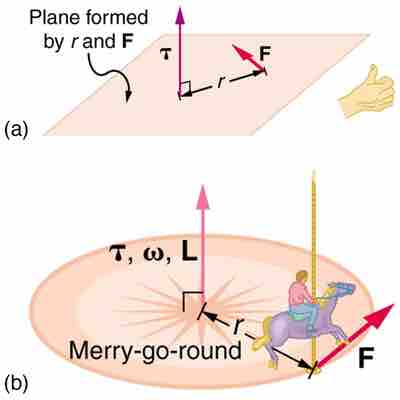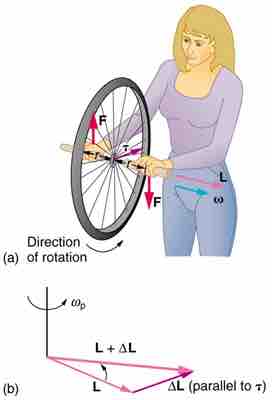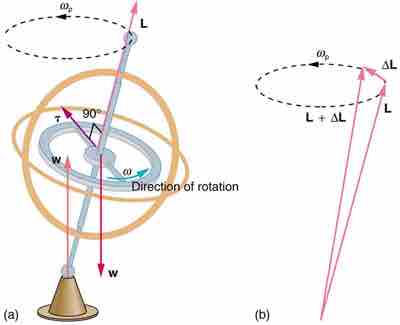A gyroscope is a device for measuring or maintaining orientation based on the principles of angular momentum. Mechanically, a gyroscope is a spinning wheel or disk in which the axle is free to assume any orientation. Although this orientation does not remain fixed, it changes in response to an external torque much less and in a different direction than it would without the large angular momentum associated with the disk's high rate of spin and moment of inertia. The device's orientation remains nearly fixed, regardless of the mounting platform's motion, because mounting the device in a gimbal minimizes external torque.
How It Works: Examples
Torque: Torque changes angular momentum as expressed by the equation,
This equation means that the direction of ΔL is the same as the direction of the torque that creates it, as illustrated in . This direction can be determined using the right hand rule, which says that the fingers on your hand curl towards the direction of rotation or force exerted, and your thumb points towards the direction of angular momentum, torque, and angular velocity.

Direction of Torque and Angular Momentum
In figure (a), the torque is perpendicular to the plane formed by r and F and is the direction your right thumb would point to if you curled your fingers in the direction of F. Figure (b) shows that the direction of the torque is the same as that of the angular momentum it produces.
Rotating wheel: Consider a bicycle wheel with handles attached to it, as in . With the wheel rotating as shown, its angular momentum is to the woman's left. Suppose the person holding the wheel tries to rotate it as in the figure. Her natural expectation is that the wheel will rotate in the direction she pushes it, however, what happens is quite different. The forces exerted create a torque that is horizontal toward the person, and this torque creates a change in angular momentum L in the same direction, perpendicular to the original angular momentum L, thus changing the direction of L but not the magnitude of L. ΔL and L add, giving a new angular momentum with direction that is inclined more toward the person than before. The axis of the wheel has thus moved perpendicular to the forces exerted on it, instead of in the expected direction.

Gyroscopic Effect
In figure (a), a person holding the spinning bike wheel lifts it with her right hand and pushes down with her left hand in an attempt to rotate the wheel. This action creates a torque directly toward her. This torque causes a change in angular momentum ΔL in exactly the same direction. Figure (b) shows a vector diagram depicting how ΔL and L add, producing a new angular momentum pointing more toward the person. The wheel moves toward the person, perpendicular to the forces she exerts on it.
Gyroscope: This same logic explains the behavior of gyroscopes (see ). There are two forces acting on a spinning gyroscope. The torque produced is perpendicular to the angular momentum, thus the direction of the angular momentum is changed, but not its magnitude. The gyroscope precesses around a vertical axis, since the torque is always horizontal and perpendicular to L. If the gyroscope is not spinning, it acquires angular momentum in the direction of the torque (L=ΔL), and it rotates around a horizontal axis, falling over just as we would expect.

Gyroscopes
As seen in figure (a), the forces on a spinning gyroscope are its weight and the supporting force from the stand. These forces create a horizontal torque on the gyroscope, which create a change in angular momentum ΔL that is also horizontal. In figure (b), ΔL and L add to produce a new angular momentum with the same magnitude, but different direction, so that the gyroscope precesses in the direction shown instead of falling over.
Applications
Gyroscopes serve as rotational sensors. For this reason, applications of gyroscopes include inertial navigation systems where magnetic compasses would not work (as in the Hubble telescope) or would not be precise enough (as in ICBMs). Another application is the stabilization of flying vehicles, such as radio-controlled helicopters or unmanned aerial vehicles.